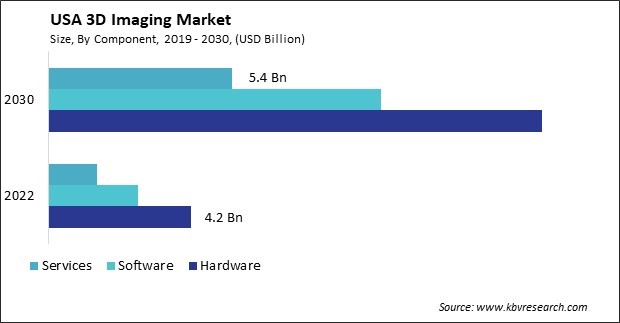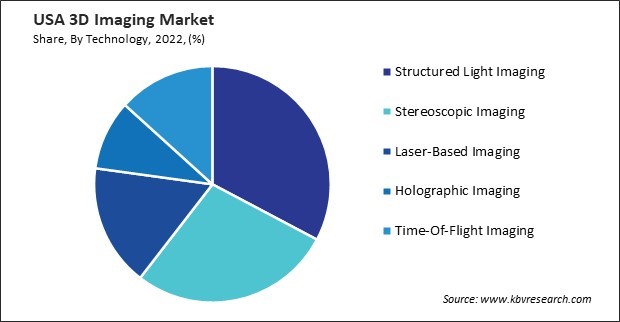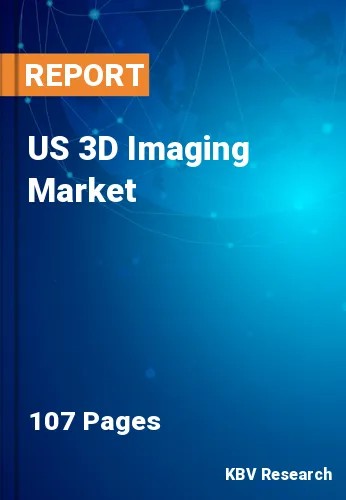The USA 3D Imaging Market is expected to reach $29.9 billion by 2030, rising at a market growth rate of 17.6% CAGR during the forecast period.
The 3D imaging market in the United States has experienced substantial growth in recent years, driven by technological advancements and increasing demand across various industries. This dynamic sector encompasses various applications, from medical imaging and industrial design to entertainment and virtual reality.

The manufacturing industry in the U.S. has embraced 3D imaging for product design, prototyping, and quality control. The ability to create detailed and accurate three-dimensional models has improved production processes and reduced time-to-market for various products. The impact of the COVID-19 pandemic on the manufacturing sector has underscored the importance of digitalization and automation, further boosting the demand for 3D imaging solutions.
In the entertainment industry, 3D imaging has become integral to the production of movies, video games, and virtual reality experiences in the United States. The immersive and realistic visual effects created through 3D imaging technologies have captivated audiences, driving investments and innovations in the sector.
The adoption of 3D imaging technology in the video game industry has been a transformative force, reshaping the gaming landscape in the United States. This dynamic shift is driven by the industry's constant quest for immersive and realistic gaming experiences. As technology evolves, developers strive to create visually stunning and lifelike worlds that captivate players. Game developers leverage advanced 3D imaging techniques to model characters with intricate details, lifelike facial expressions, and realistic movements. This enhances the overall gaming experience, allowing players to engage with virtual worlds in unprecedented ways.
Furthermore, virtual reality (VR) and augmented reality (AR) technologies have gained traction in the U.S. gaming industry, and 3D imaging market plays a pivotal role in enhancing these experiences. 3D imaging in VR headsets allows for a more convincing sense of depth and spatial awareness, creating an even more immersive environment for players. In multiplayer and online gaming, 3D imaging enhances graphics and realistic simulations, fostering a sense of presence and connectivity among players. This has become crucial in attracting and retaining a diverse player base.
According to the International Trade Administration, gaming has become a pervasive presence in the United States, with 75% of households having at least one gamer. Notably, the pandemic catalyzed increased sales, witnessing a remarkable 31% surge in consumer spending on video gaming and subscription services in the U.S. Mobile gaming, in particular, experienced significant growth, with revenues soaring to $77.2 billion in 2020, marking a substantial 13.3% increase. Recognizing the potential for expansion, 80% of U.S. gaming companies actively explore international industries to broaden their sales horizons.
Connecting this flourishing landscape to the realm of 3D imaging technology in the U.S. video game industry, the adoption of advanced imaging techniques has become increasingly pivotal. The surge in consumer interest and spending has paved the way for a more immersive gaming experience, driving the demand for cutting-edge technologies like 3D imaging. As U.S. gaming companies see global expansion, integrating innovative visual elements facilitated by 3D imaging is poised to play a crucial role in captivating international audiences. Hence, the widespread adoption of 3D imaging technology has revolutionized the U.S. gaming industry, elevating realism and immersion in gaming experiences.
The automotive sector in the United States has witnessed a remarkable expansion in recent years, driven partly by technological advancements that have transformed the industry. One such transformative element is the widespread adoption of 3D imaging technology, which has found a burgeoning industry within the automotive sector. This technology has permeated various aspects of the automotive value chain, from design and manufacturing to marketing and customer experience.
In automotive design and prototyping, 3D imaging has become an indispensable tool, enabling engineers and designers to create highly detailed and accurate three-dimensional models of vehicles. This not only accelerates the product development cycle but also enhances the precision and quality of the designs. The ability to visualize and manipulate these 3D models facilitates collaborative efforts among cross-functional teams, leading to more efficient decision-making processes.
In manufacturing, 3D imaging has streamlined production processes and improved quality control. Automated inspection systems employing 3D imaging technologies ensure that components and finished products meet stringent quality standards. This reduces production costs and enhances overall product reliability and safety. Virtual showrooms and online configurators utilize this technology to provide customers with immersive and interactive experiences.
According to Select USA, in 2019, the automotive industry in the United States achieved a substantial milestone, generating a revenue of $143.3 billion. This robust performance set the stage for further growth and development within the sector. Additionally, 2020 witnessed a noteworthy expansion as the United States successfully exported 1.4 million new light vehicles and 108,754 medium and heavy trucks, totaling a combined value exceeding $52 billion. This exportation extended to more than 200 global industries, showcasing the industry's reach and impact on an international scale. Furthermore, automotive parts exports contributed significantly to this momentum, with a valuation of $66.7 billion.
The thriving automotive sector, coupled with its global outreach, acts as a driving force in integrating and utilizing 3D imaging technologies within the U.S. automotive industry. The sector's commitment to innovation and global engagement positions it as a key player in shaping the country's 3D imaging market trajectory. Therefore, the significant expansion of the U.S. automotive sector is underscored by the transformative impact of 3D imaging technology, revolutionizing design, manufacturing, and customer engagement.

The 3D imaging market in the United States has experienced significant growth and innovation, driven by the increasing demand for advanced imaging technologies across various industries. Autodesk Inc. is a global 3D design, engineering, and entertainment software leader. The company provides a wide range of 3D imaging solutions for architecture, engineering, and construction industries. Autodesk's software, including AutoCAD and Maya, enables professionals to create and visualize complex 3D models, fostering innovation and efficiency in design processes.
General Electric is a conglomerate with diverse business operations, including a significant presence in the healthcare sector. In medical imaging, G.E. has pioneered advanced 3D medical imaging technologies such as C.T. scans and MRIs. Their cutting-edge medical imaging solutions contribute to improved diagnostic accuracy and patient care.
Trimble Inc, based in Sunnyvale, California, is another major player in the U.S. 3D imaging sector. Specializing in positioning technologies, Trimble offers advanced 3D scanning and imaging solutions. These technologies find applications in construction, agriculture, and geospatial industries, enabling precise data capture and modeling. These companies represent a snapshot of the diverse and dynamic 3D imaging market in the United States.
3D Systems Corporation, headquartered in Rock Hill, South Carolina, is a key player focusing on additive manufacturing and 3D printing technologies. The company's solutions span various industries, including healthcare, aerospace, and automotive. 3D Systems' expertise is creating detailed and accurate 3D models using various printing techniques. These companies collectively showcase the diversity of the 3D imaging market in the U.S., with applications ranging from design and manufacturing to healthcare, entertainment, and beyond.
By Component
By Technology
By Vertical
Our team of dedicated experts can provide you with attractive expansion opportunities for your business.

